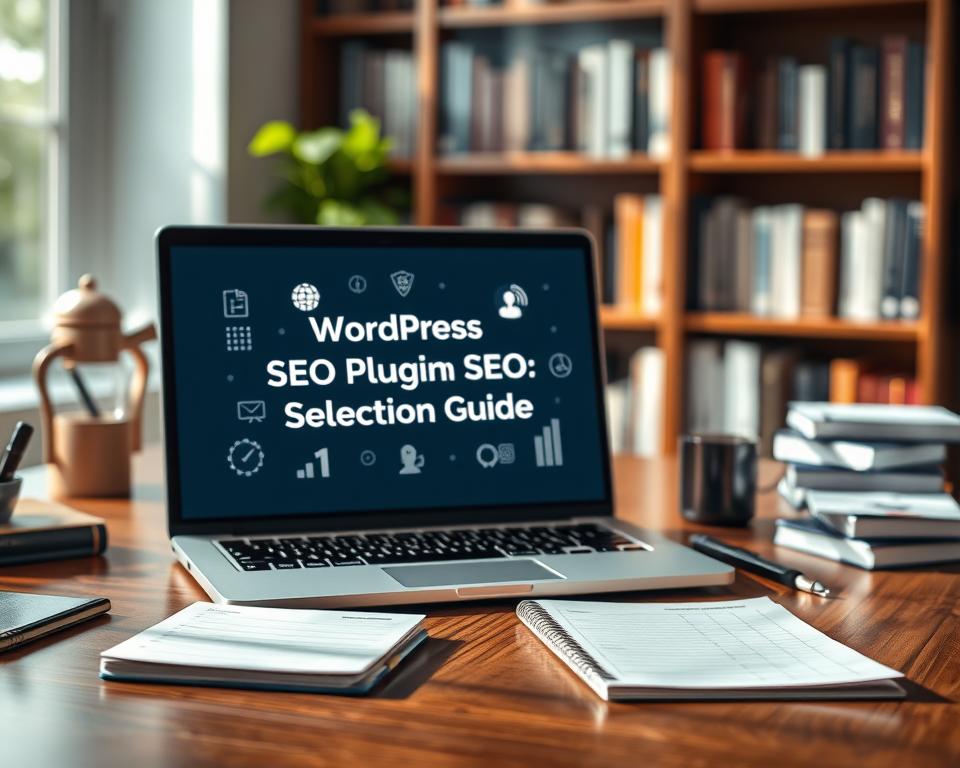Excel at SEO on WordPress: Concise Handbook
It might surprise you to learn that Nearly 4 out of 5 of companies using WordPress achieve better search-engine rankings after implementing strategic SEO initiatives. WordPress SEO fine-tuning has grown into a vital component for digital victory. It turns sites from obscure to unmissable for search engines.
WordPress supplies a robust foundation for digital creators seeking to boost their search presence. With built-in features and adaptable optimization tools, WordPress SEO offerings can assist businesses move up SERPs efficiently. SEO Marketing Nerds suggest leveraging these native functions to build a strong digital profile.
This guide will take you through the best SEO on WordPress, unveiling expert tactics that convert your site into a SERP magnet. If you’re a consultant specializing in WordPress SEO or a business owner, these steps will enable you unlock your site’s full potential using SEO for WordPress.
From learning basic optimization methods to deploying advanced tactics, this guide supplies ready-to-use guidance to boost your WordPress site’s search performance. Gear up to delve into the realm of WordPress SEO and see your web exposure rise.
Getting to Know WordPress SEO Essentials
WordPress and SEO are in ideal alignment, improving your site’s visibility in search results. As a powerful content management system, WordPress lays a strong foundation for SEO efforts.
Grasping WordPress SEO basics can transform your site’s web stance. It delivers distinct advantages for SEO specialists and site owners alike:
- Semantic HTML markup
- Mobile-friendly themes
- Straightforward content management
- Vast plugin marketplace for SEO enhancements
Choosing WordPress.org over WordPress.com gives you complete control for SEO fine-tuning. The self-hosted version allows for greater customization, essential for in-depth SEO methods.
WordPress’s SEO advantages are many:
- Adjustable permalink structures
- Rapid content posting
- Simple metadata management
- Integrated features for search-engine indexing
To raise SEO on a WordPress site, it’s vital to grasp these basic components. Effective WordPress SEO requires a deliberate blend of technical tuning and valuable content.
Insider tip: A WordPress SEO specialist always values user experience alongside search-engine criteria.
Essential WordPress SEO Adjustments
Configuring the right SEO settings is vital for any WordPress site. A well-configured WordPress SEO configuration can dramatically enhance your site’s search-engine performance and exposure. Professional WordPress SEO firms recommend a planned approach to these key configurations.

Below are the crucial settings that make your WordPress site search-friendly:
- Configure Permalink Settings
- Use clean, descriptive URL structures
- Include relevant keywords in permalinks
- Avoid long, complex URL slugs
- Build XML Sitemap
- Create a detailed site map
- Submit to Google Search Console
- Verify all key pages are crawled
- Activate SSL Cert
- Switch to HTTPS for enhanced security
- Improve WordPress Google SEO ranking signals
- Safeguard user data
A WordPress SEO pro plugin can simplify these settings. During your WordPress SEO review, prioritize maintaining a technically sound foundation that search engines will value. Prioritize logical architecture, fast loading speeds, and logical content hierarchies.
Insider Advice: Consistent optimization is critical to maintaining strong search-engine ranking.
Remember, these WordPress SEO-friendly settings are your first step toward better online visibility and search rankings.
Applying SEO in WordPress
To enhance your WordPress site’s visibility, a well-planned approach is crucial. Learning how to implement SEO to WordPress can dramatically improve your web footprint and attract more relevant visitors.
Many strategies can enhance your site’s search-engine ranking. These include:
- Perfect title tags and meta descriptions
- Publish high-quality content
- Leverage local SEO WordPress techniques
- Build strong internal links
- Boost image optimization
WordPress SEO best practices stress several key areas. High-quality content is still the #1 factor in search-engine rankings. Your website should offer unique information that meets user intent.
For regional brands, focusing on geographic-specific keywords is crucial. This includes using location-based terms and producing content that speaks with your local audience.
Successful SEO is about building a frictionless user experience while showing authority to search engines.
Technical tuning is a key component of your WordPress SEO strategy. Ensure your website loads quickly, is responsive, and has a well-organized, logical structure. This makes it easier for search engines to crawl your site.
Choosing the Right SEO Plugin for WordPress
Choosing the ideal SEO plugin can significantly boost your WordPress website’s search performance. No matter if you’re a novice or an experienced SEO pro, you need capable tools to refine your site efficiently.
When reviewing WordPress SEO plugins, consider these critical factors:
- Easy-to-use interface for on-page optimization
- Comprehensive optimization features
- Live content analysis capabilities
- XML sitemap generation
- Schema markup capability
Top WordPress SEO plugins to consider include:
- Yoast SEO: Powerful content optimization tool
- All in One SEO Pack: Comprehensive feature set
- Rank Math: Granular configuration options
A WordPress SEO consultancy typically suggests plugins that ease technical optimization while delivering detailed site analysis. Key considerations include ease of use, performance overhead, and alignment with your specific SEO site WordPress objectives.
Expert insight: Always trial plugins in a test environment before production implementation.
Choose a plugin that matches your comfort zone and offers actionable guidance for improving your site’s search-engine rankings.
WordPress On-Page SEO Methods
Perfecting on-page SEO is essential for WordPress sites striving for better search-engine rankings. Basic SEO WordPress tactics can greatly increase your content’s performance. This, in turn, draws more organic traffic to your site.
Primary optimization techniques include:
- Crafting compelling title tags with target keywords
- Composing descriptive meta descriptions
- Arranging content with logical header tags
- Creating keyword-rich URLs
When using WordPress SEO support, it’s important to craft descriptive title tags. These should be between 50-60 characters long. Position your primary keyword at the beginning and include your brand name at the conclusion. These strategies aid search engines understand your content’s relevance.
For optimal results, concentrate on fine-tuning your content format. Use h1 tags for main titles, h2 for section headings, and H3 for subsections. This hierarchical approach enhances both readability and SEO performance.
URL optimization is another vital aspect of SEO optimization WordPress. Make certain your URLs are concise, meaningful, and contain targeted keywords. Steer clear of complex structures that can confuse users and search engines alike.
Don’t forget: On-page SEO is about creating high-value, comprehensible content that benefits both users and search algorithms.
Optimizing Content for SEO
Developing effective content is the cornerstone of WordPress search optimization. An efficient WordPress SEO optimization service requires a strategic content approach that engages both search engines and visitors.
Using WordPress longtail keyword SEO includes several vital steps:
- Carry out thorough keyword research to identify targeted search terms
- Create content that directly answers user questions
- Provide distinct, valuable insights not found elsewhere
- Arrange content for easy scanning
When tuning SEO on WordPress, focus on crafting excellent content that offers true value. Quality beats quantity always. Use long-tail keywords organically within your text, ensuring they flow seamlessly with the content.
To boost SEO WordPress performance, consider these content tactics:
- Publish comprehensive articles
- Frequently update older content
- Employ internal linking to link related posts
- Stick to a consistent publishing schedule
Strong content is the bridge between your website and your visitors’ needs.
By using these WordPress search optimization techniques, you’ll create engaging content that not only ranks well but also offers tangible value to your visitors.
Technical SEO Tactics
Technical SEO is the heart of a winning WordPress site optimization roadmap. The optimal technical elements can significantly improve your website’s search-engine results and user experience.
When configuring SEO for WordPress, multiple key technical factors need attention. Site speed is a primary ranking factor that immediately impacts search results. Google’s Core Web Vitals now measure websites based on loading performance, interactivity, and visual stability.
- Improve site speed through caching mechanisms
- Cut down HTTP requests
- Shrink and scale images
- Take advantage of browser caching
For WordPress site SEO optimization, think about implementing structured data and schema markup. These technical elements allow search engines get your content with greater accuracy. This can potentially boost rich snippet displays in search results.
Mobile optimization is another vital technical SEO component. With mobile-first indexing, guaranteeing your WordPress website performs seamlessly across devices is crucial. Responsive design and fast mobile loading speeds are now compulsory for ranking well.
Expert note: Use premium SEO WordPress plugins to streamline complicated optimization tasks.
By applying these technical SEO methods, you’ll establish a solid foundation for better search-engine visibility and user engagement on your WordPress website.
SEO-Focused Image Tactics
Images is essential for WordPress sites. Tuning images for SEO can greatly enhance your site’s performance and search results. Well-optimised and tagged images boost user experience and SEO.
Strong image optimization involves several key strategies:
- Shrink images to minimize file sizes while retaining quality
- Use descriptive file names containing target terms
- Add keyword-based alt text for search-engine understanding
- Use lazy loading to improve page load times
When tuning your WordPress site for SEO, remember these image optimization techniques:
- Choose the right file format (JPEG for photographs, PNG for graphics)
- Scale images before uploading
- Use WordPress SEO plugins like Yoast or EWWW Image Optimizer
“Images are not just visual elements; they’re powerful SEO tools when used smartly.” — Digital Marketing Expert
Incorporating WordPress SEO internal links and WordPress SEO links within image captions can further improve your website’s search visibility. Remember, well-optimized images result in faster load times and improved user engagement.
Site Architecture & Internal Links
Internal linking is a core element in technical SEO for WordPress, noticeably enhancing your site’s search-engine results. It assists search engines grasp your site’s structure and distributes page authority evenly. This is essential for better search-engine visibility.
When optimizing your WordPress site for search engines, remember these important internal linking tactics:
- Create a logical site hierarchy for easy navigation
- Use contextual anchor text for clarity
- Link to related content on your WordPress homepage
- Prioritize connecting with your money pages
For effective SEO on your WordPress site, link contextually. This entails placing links where they provide real value to readers. Strategic internal linking greatly benefits WordPress on-page SEO, assisting search engines in understanding your site’s content structure.
Pro Tip: Think of internal links as a roadmap that directs both users and search engines through your website’s ecosystem.
By adopting a strategic internal linking approach, you’ll improve user experience, improve site navigation, and increase your WordPress site’s search-engine visibility.
WordPress Speed & Rankings
Site speed is a significant factor in WordPress SEO performance. Search engines, like Google, prefer websites that load quickly. This makes speed optimization vital for better search positions and a better user experience.
To boost your WordPress site’s speed, begin by measuring its current performance with tools like Google PageSpeed Insights. This tool pinpoints areas for enhancement in loading times.
- Apply caching plugins for WordPress SEO optimization
- Use a Content Delivery Network (CDN)
- Reduce HTTP requests
- Shrink images and media files
Yoast SEO WordPress users can get extra speed optimization features. Reducing server response times and pruning your WordPress database are essential for improved site performance.
Important WordPress SEO pointers for speed include:
- Choose lightweight themes
- Delete unnecessary plugins
- Activate browser caching
- Shrink and optimize images
By implementing these SEO on-page WordPress strategies, you’ll achieve a speedier, leaner website. This will help it to rank better in search results.
Mobile SEO for WordPress
In today’s connected era, mobile optimization is critical for WordPress sites. Google now evaluates mobile versions first, impacting your site’s search results. A WordPress SEO guide must highlight responsive design for a consistent user experience on all devices.
For mobile-friendly WordPress sites, consider these SEO optimization WordPress tactics:
- Pick a responsive WordPress theme that adapts to different screen sizes
- Improve page loading speed for mobile devices
- Guarantee readable text without zooming
- Create touch-friendly navigation elements
When optimizing for WordPress, test your site’s mobile performance with Google’s Mobile-Friendly Test. WordPress SEO optimizer plugins can quickly identify and correct mobile issues.
Key mobile optimization techniques comprise:
- Optimize images for faster mobile loading
- Use responsive design frameworks
- Deploy AMP (Accelerated Mobile Pages)
- Fine-tune SEO title WordPress for mobile search results
By focusing on mobile optimization, you boost user experience and raise search rankings. Search engines give priority to sites with great mobile performance, boosting your visibility in search results.
Conclusion
Dominating the best SEO WordPress strategies requires persistence and a commitment to lifelong learning. The techniques we’ve outlined offer a reliable foundation for improving your website’s search-engine visibility. From picking the right SEO plugins to implementing technical optimizations, you now have a comprehensive set of tools to enhance your site’s performance.
SEO with WordPress is a continuous journey of optimization, not a single task. By regularly applying these SEO strategies, you’ll notice your site’s rankings increase and pull more organic traffic. The secret lies in being flexible and constantly learning about the latest search-engine algorithms and optimization methods.
SEO Marketing Nerds advise adopting a comprehensive approach to SEO on WordPress. This involves focusing on content quality, technical performance, user experience, and strategic keyword use. Each element is essential for search engines to interpret and rank your site properly.
As you continue to apply SEO on WordPress, keep in mind that steady effort are your most important assets. Monitor your progress, study your outcomes, and be ready to refine your approaches. With steady effort and the right methodology, you’ll see remarkable improvements in your website’s search-engine results.

